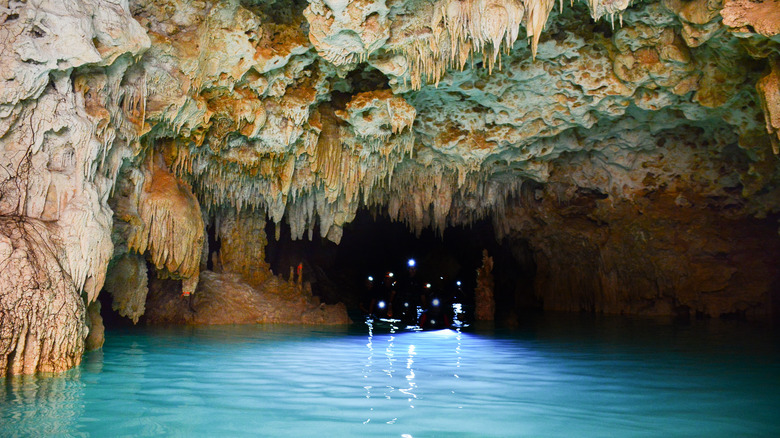Would you dare to enter Xibalba, the Mayan underworld, and turn off your headlamp? If you’re up for a little adventure, caving is one of the most popular excursions you can do in Belize. This rich land of natural wonders is home to thousands of cave systems, many of which can be experienced by hiking, swimming, kayaking, and horseback riding. But for a truly unique bucket list experience you won’t forget, you’ve got to try it on an inner tube.
Not only are the caves gorgeous, but these limestone labyrinths hold historical significance. Caves were regularly visited by the Mayans who inhabited the region for thousands of years, viewed as a sacred place to perform rituals, bury the departed, drink hallucinogenic substances, and send sacrifices to the gods. Today, the subterranean tunnels still hold traces of the past with preserved footprints, pottery, artifacts, and human remains. With the sensitive nature of these areas, it’s best to explore the cave systems with a guide.
Nohoch Che’en Caves Branch

About 30 minutes outside of Belmopan, Nohoch Che’en Caves Branch Archaeological Reserve — Caves Branch, for short — is one of the most popular places to go cave tubing in Belize. There are dozens of tour operators you can find online with day trips ranging from $49 to $200. Prices can vary depending on the length of the tour and whether you pair cave tubing with other activities, like ziplining, horseback riding, and Mayan pyramid tours. You can also ask your hotel which tour companies they recommend or, in some cases, simply show up and join a tour.
If you forgot some essentials, you’ll find vendors at the entrance of Caves Branch with everything you need for a successful journey, like sunglasses, sunscreen, and waterproof phone holders. Your guide will supply you with an inner tube, helmet, headlamp, and a safety tutorial. From there, some tours start with a 45-minute hike upstream along the Caves Branch River, while the more laid-back options take you on a jungle bus and drop you off near the cave entrance.
Once you’re inside the cave, expect to see stalactites hanging from the ceiling, stalagmites coming up from the floors, and other fascinating natural wonders. You may find bats sleeping in some chambers or hear the rush of an underground waterfall nearby. Every once in a while, the sunlight will burst through a crack in the rock or a cave opening. You’ll look around to see the lush rainforest before floating back into the darkness once more.
St. Herman’s and cave etiquette

St. Herman’s Blue Hole National Park is another popular cave tubing destination adjacent to Caves Branch. This reserve has shorter tours, ranging from 30 minutes to three hours, which may be more suitable for someone who can’t fathom spending half a day underground, as you would on some of the longer routes (like the 7-miler). Once your tour ends, you’ll be able to hike a trail to a sunken limestone cenote, the Spanish word for sinkhole, and take a dip in a turquoise pool surrounded by stunning scenery.
Water levels may vary throughout the year, but the best time to visit is December through February, which boasts the best weather. If you’d prefer fewer crowds and cheaper prices, book your trip during the shoulder from August to November. No matter which cave tour you choose, be sure to wear durable shoes, bug spray, and clothing you don’t mind getting wet. Last, but certainly not least, don’t take anything from the caves and be sure to offer a few words of gratitude, notes the Heritage Education Network of Belize via the Belize Tourism Board. It’s not every day you’re in the depths of the underworld, after all.

